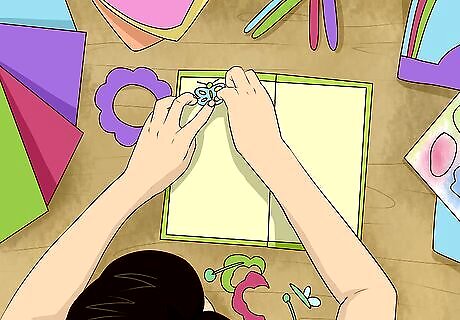
views
Preparing a Journal

Find a notebook to write in. The book can be simple or ornate. If you're happy with a simple journal, then just buy a basic college-ruled notebook. If you want something more serious, look for a nice leather-bound journal – perhaps even one with a lock and key! Choose between a lined or an unlined notebook. A lined notebook can be better for writing, while an unlined notebook might facilitate art and drawing. Think about how you prefer to set down your ideas, and choose a notebook that inspires you to fill it. If you plan to carry your notebook with you (in your purse, pack, or pocket,) make sure to use a notebook that is small enough to conveniently pack around.

Decorate the notebook. Make the journal your own by infusing it with a unique style. Personalize the covers with words, art, stickers, and colors. Take clippings from your favorite magazines, and post them on the inside or outside of the journal. If decoration isn't your thing, then feel free to leave the journal plain! Consider numbering the pages. You can do this all at once, or you can gradually number the pages as you fill them. This can be a great way to keep track of what you write.

Keep a digital journal. This can be a secure and easy-access means of preserving your thoughts. Log your entries in Microsoft Word or another basic word processor. Save the entries in a special folder, or compile them into a single, canonical document. Consider using a system that you can access with a password through a cloud or over the Internet. This way, you can open and edit your journal from any computer or device! Try WordPress, or even using your email client. For all the benefits of digital journal-keeping, you may miss the charm of a physical journal. Try it out, if you're curious. Consider keeping some notes in a physical notebook, and others in a drive on your computer.
Starting to Journal

Write the first entry. The most important step of starting a journal is actually setting down the first entry. The notebook, the decoration, and the security are all just ways of making the journal feel like a safe space for you to write. Think about the sort of journal that you keep. Then, write what's on your mind. Write about what happened today. Include where you went, what you did, and who you spoke to. Write about what you felt today. Pour your joys, your frustrations, and your goals into the journal. Use the act of writing as a way to explore your feelings. Consider keeping a dream journal. Keep a learning log. Write about what you learned today. Use the journal as a way to explore and connect your thoughts. Turn your experiences into art. Use the journal to write stories or poetry, to make sketches, and to plan out projects. Feel free to mix this in with your other entries.

Date your entry. If you are going to keep a regular journal, then it's good to establish some way of tracking when you wrote what. Write the full date, or whatever you'll need to jog your memory: e.g. 2/4/2016 or Feb. 4, 2016. For a slightly more involved record, write the time of day (morning, afternoon, night), your mood, and/or your location. Log the date at the top of the page or the top of each entry.

Get into the flow of writing. Try not to think too critically about what you're setting down. Let go of your doubts, and write your truth. The beauty of a journal is that you can tell the story that you don't usually tell people: the deep thoughts and feelings that lie behind your day-to-day decisions. Take the opportunity to explore yourself. Imagine that you are talking to someone. Whether you are talking to a close friend or pouring your thoughts into a journal: you are putting them out into the world, and thus making them real. It can be hard to really get a grasp on what you're thinking until you make your thoughts real. Use journaling as a healing tool. If there is something haunting you or bothering you, try to write about that thing and understand why exactly it has stuck on your mind.

Think before you write. If you're having trouble finding your flow, try taking a few minutes to quietly reflect on what you're feeling. The act of writing can help you tease out these feelings. However, it can be hard to write until you have a clear idea of where to begin.

Time yourself. Try setting aside a discrete amount of time to write in your journal. Set a timer for 5 to 15 minutes, and then let yourself go. The "deadline" of the ticking clock may help motivate you to get writing. Don't worry about making it perfect! Simply write down everything that's on your mind. If the timer goes off and you haven't finished journaling, then feel free to keep going. The point of the timer is not to limit you, but rather to spur you. This can be a great way to fit your journaling practice into the busy flow of everyday life. If you have trouble finding the time to write in your journal, then you may need to schedule it in.
Keeping a Journal

Carry the book with you. This way, you can record your thoughts whenever they strike. Keep the journal in your purse, your pack, or your back pocket. When you have a free moment, try pulling out your journal instead of your cell phone. You may find that this helps you stay grounded on a day-to-day basis. Carrying the journal around has the added bonus of keeping your words private. If you always keep your journal close, then it's less likely to fall into the wrong hands.

Keep your journal private. If you've poured your deep, personal thoughts into this journal, then you probably don't want anyone else to read it. Hide the journal somewhere that no one else will find it. Great hiding places include: Behind the books on your bookshelf. Under your mattress or pillow In the drawer of your bedside table Behind a picture frame
Keep the cover discrete. Do not label the journal things like "Private!" or "Do NOT read!" This will make people curious and want to read it even more. It would be best to leave the cover blank or to disguise it as something more boring, such as "Homework" or "Shopping Lists." If you do want to label it "My Journal" or "Private!" be sure to hide it well.

Write regularly. Make a practice of keeping a journal. Reap the various mental-health benefits of staying in touch with your emotions on a day-to-day basis. Each time you write in your journal, remind yourself to be honest and tell the whole truth. Try scheduling journal time into your day-to-day flow. Some people journal before bed, or immediately after they wake. Some people journal during their daily commute or during their lunch hour. Find a time that works for you.

Journal when you need to heal. Studies have indicated that writing in a journal can be a powerful way to process grief, trauma, and other emotional pains. Let your writing habit hold you up when you feel that everything is falling apart.


















Comments
0 comment